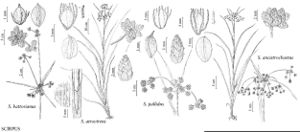Scirpus hattorianus
J. Jap. Bot. 8: 44. 1933.
Plants cespitose; rhizomes short, tough, fibrous. Culms: fertile ones upright or nearly so; nodes without axillary bulblets. Leaves 3–9 per culm; sheaths of proximal leaves light-brown; proximal sheaths and blades with septa few-to-many, rather inconspicuous; blades 20–35 cm × 5–9 mm. Inflorescences terminal; rays ascending or divaricate (usually both in the same inflorescence), rays often bearing axillary bulblets, proximal branches smooth, distal branches scabrellous to scabrous; bases of involucral-bracts green, margins usually speckled with redbrown, rarely solid black, not glutinous. Spikelets in dense clusters of 4–55 (largest cluster with 15 or more), spikelets sessile, ovoid or broadly ovoid, 2–3.5 × 1.3–2.5 mm; scales blackish or occasionally brownish with pale midribs, elliptic or broadly elliptic, 1–1.4 (–2) mm, apex mucronate, mucro 0.1–0.2 mm. Flowers: perianth bristles persistent, (4–) 5–6, slender, straight or curved, shorter than to equaling achene, with retrorse, thin-walled, round-tipped barbs in distal (0.1–) 0.2–0.4, enclosed within scales; styles 3-fid. Achenes pale-brown, elliptic or obovate in outline, plumply trigonous, (0.6–) 0.7–1.1 × 0.3–0.5 mm. 2n = 56.
Phenology: Fruiting late spring–early summer (Jun–early Jul).
Habitat: Moist meadows, marshes, and ditches
Elevation: 0–800 m
Distribution

St. Pierre and Miquelon, N.B., Nfld. and Labr., N.S., Ont., Que., Conn., Ill., Ind., Maine, Md., Mass., Mich., Minn., N.H., N.J., N.Y., N.C., Ohio, Pa., R.I., Vt., Va., W.Va., Wis., Asia (Japan), Asia (probably from North America)
Discussion
Scirpus hattorianus has been confused in the past with both S. atrovirens and S. georgianus. Scirpus hattorianus tends to be a more slender plant, and the scales of its spikelets are usually black, not brown. The perianth bristles are superficially intermediate between the other two. They are typically shorter and more delicate than those of S. atrovirens. In S. hattorianus the longest bristles are usually only 0.6–0.8 times as long as the achene, and barbed in the distal (0.1–)0.2–0.4; in S. atrovirens the longest bristles are usually 0.9–1.2 times as long as the achene and barbed in the distal 0.3–0.6. Some individuals fall outside these ranges and identification must be based on comparison of all the characters mentioned in the key. Separation from S. georgianus is discussed under S. georgianus.
Scirpus hattorianus occasionally hybridizes with S. ancistrochaetus, S. atrocinctus, S. atrovirens, S. georgianus, and S. pedicellatus. The name Scirpus peckii Britton has been applied to hybrids between S. hattorianus and S. atrocinctus or S. pedicellatus.
Selected References
None.
Lower Taxa
"shortened" is not a number.
